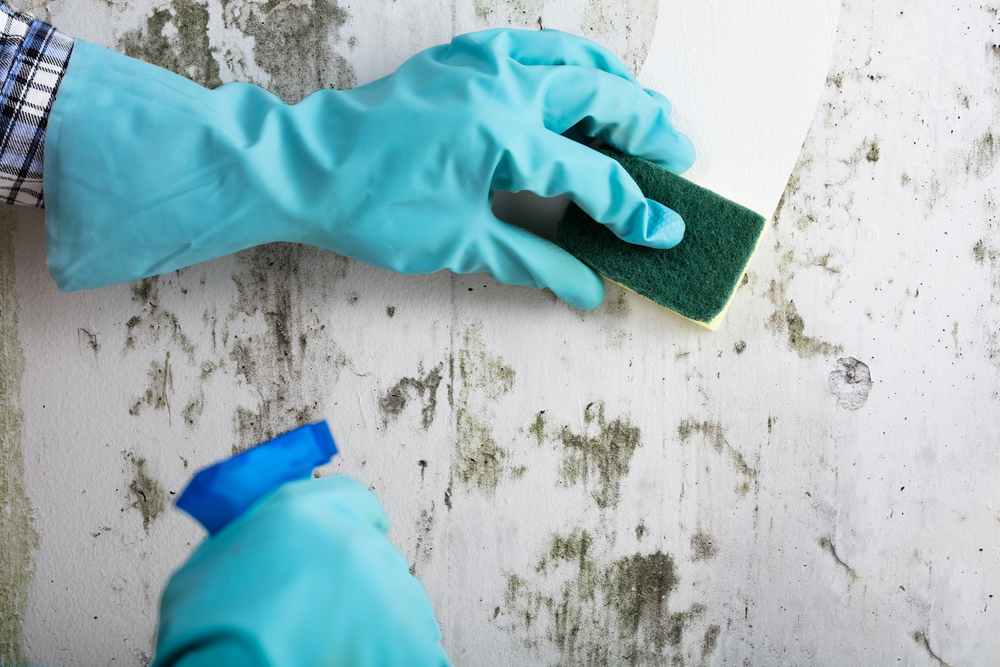Mould on the walls isn’t just unsightly, it can be dangerous for your health. Black and green in appearance, mould grows and thrives in damp, warm conditions. Rooms with poor ventilation and damp patches, or those affected by leaks, create the perfect condition for mould to thrive on windows and walls.
If mould is left untreated, toxins may be released into the air, potentially causing allergic reactions and various other health concerns. Not only is mould harmful to your health, if it’s not removed, it will continue to grow and damage your home’s walls.
See below for our step-by-step guide on how to remove small patches of mould from your walls. Although there are things you can do to remedy small areas of mould, we strongly suggest getting in touch with an expert to protect your health and to permanently get rid of mould on your walls – particularly for bigger jobs.
It’s important to note, however, that the below method is applicable to painted plaster walls, not plasterboard walls. Due to the nature of plasterboard walls, although a mould wash concentrate may remove surface mould, it cannot remove mould that may be growing deep inside the layers of plasterboard. We highly recommend seeking an expert’s help to ensure the correct measures are taken if you have plasterboard walls.
1. Gather the required equipment
Before you begin, you’ll need to make sure you have all the necessary equipment:
- Personal Protection Equipment including an N-95 respirator to cover nose and mouth, an apron, rubber gloves, and suitable eye protection.
- A plastic bag / bin liner
- Mould Wash Concentrate
- Bucket and clean sponge
- Dry cloth
- Disposable plastic sheet
2. Prepare your space
The next step is to prepare your space to ensure safe and smooth removal.
Firstly, ensure you are wearing your PPE correctly. This will help to protect you from any toxins or harmful effects mould may cause.
Ensure your room is well ventilated by opening all windows and hiring a professional air scrubber. We recommend the HEPA Air Scrubber, a high efficiency air filtration system which cleans the air of unwanted particles and odours, great for properties affected by mould.
Next, using your plastic bag / bin liner, remove any soft furnishing from the room including clothes or bed linen, for example. Once removed, these should be safely disposed of or thoroughly cleaned using a professional cleaning service.
Then, place a disposable plastic sheet down underneath the affected area to catch any mould that may drop during the cleaning process. Ensure you also cover anything that cannot be removed from the affected room.
3. Wash down walls
The next step is to begin washing down the affected area. Ensure you remove any loose material such as peeling wallpaper or flaking paint before you begin.
We recommend using a Mould Wash Concentrate, a concentrated fungicidal wash and surface biocide that removes mould fungi. Using your bucket and sponge, simply follow the instructions on the product and test a small, conspicuous area before continuing.
Proceed to clean the affected area, making sure not to scrub too hard in order to minimise any toxins that may be released from the mould spores.
4. Dry your walls
Once step three is complete, use your dry cloth to remove any moisture left on the affected area. Now wait for the walls to fully dry, ensuring the room is well ventilated by opening windows and using a professional air scrubber as mentioned in step two.
5. Repeat steps three and four
To ensure that mould has been removed from a particularly stubborn area, repeat steps three and four on the affected area. Ensure you allow time for the walls to fully dry between steps.
6. Ventilate and clear your room
Finally, allow the area to dry completely and ensure good ventilation in the affected room using the above-mentioned methods in step two.
Make sure to correctly dispose of any equipment used and ensure the area is clear. Once this is done, safely remove and dispose of your PPE correctly.
Stay Safe & Employ an Expert
Cleaning up mould can be a difficult and lengthy task. Whilst the above steps may help to remove small areas of mould, this process is not guaranteed to completely remove mould from your walls. To ensure safe and complete removal, especially if you have large affected areas, we strongly advise you get in touch with an expert.
With full UK coverage and 35 years’ experience, Restorations [UK] is a reputable mould removal specialist, able to offer the latest mould remediation techniques for domestic or commercial jobs, big, or small.
The first step to mould remediation is to have a mould survey conducted by a trained remediation specialist. You will then be advised on whether it’s safe to reside in the property, and you will receive an in-depth plan of what is necessary to eliminate the problem.
Get in touch today for a free quote.


